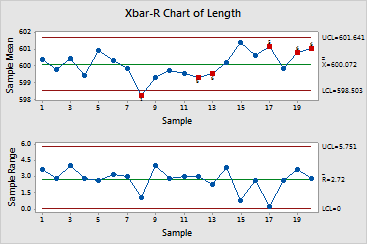|
|
Xbar-R ChartGraphs - Xbar Chart |
![]() charts assess whether the process center
is in control.
The
charts assess whether the process center
is in control.
The ![]() chart consists of the following:
chart consists of the following:
Minitab conducts up to eight tests for special causes
for the ![]() chart, which detect points beyond the control
limits and specific patterns in the data. Points that fail are marked
with a red symbol and the number of the failed test. Complete results
are available in the Session window. A failed point indicates that there
is a nonrandom pattern in the data that may be the result of special-cause variation.
These points should be investigated.
chart, which detect points beyond the control
limits and specific patterns in the data. Points that fail are marked
with a red symbol and the number of the failed test. Complete results
are available in the Session window. A failed point indicates that there
is a nonrandom pattern in the data that may be the result of special-cause variation.
These points should be investigated.
The R chart must be in control before you can interpret the ![]() chart. If the R chart is not in control then the control
limits for the
chart. If the R chart is not in control then the control
limits for the ![]() chart will be inaccurate and may inappropriately
signal an out-of-control condition on the
chart will be inaccurate and may inappropriately
signal an out-of-control condition on the ![]() chart.
chart.
Example Output |

Interpretation |
For the camshaft data, the R chart is in control, therefore it is appropriate
to examine the ![]() chart. The
chart. The ![]() chart for the
camshaft data can be summarized as follows:
chart for the
camshaft data can be summarized as follows:
These test results indicate that the process average is unstable and the process is out of control, possibly due to the presence of special causes. Next, you would try to identify and correct the factors contributing to this special-cause variation. Until these causes are eliminated, the process cannot achieve a state of statistical control.